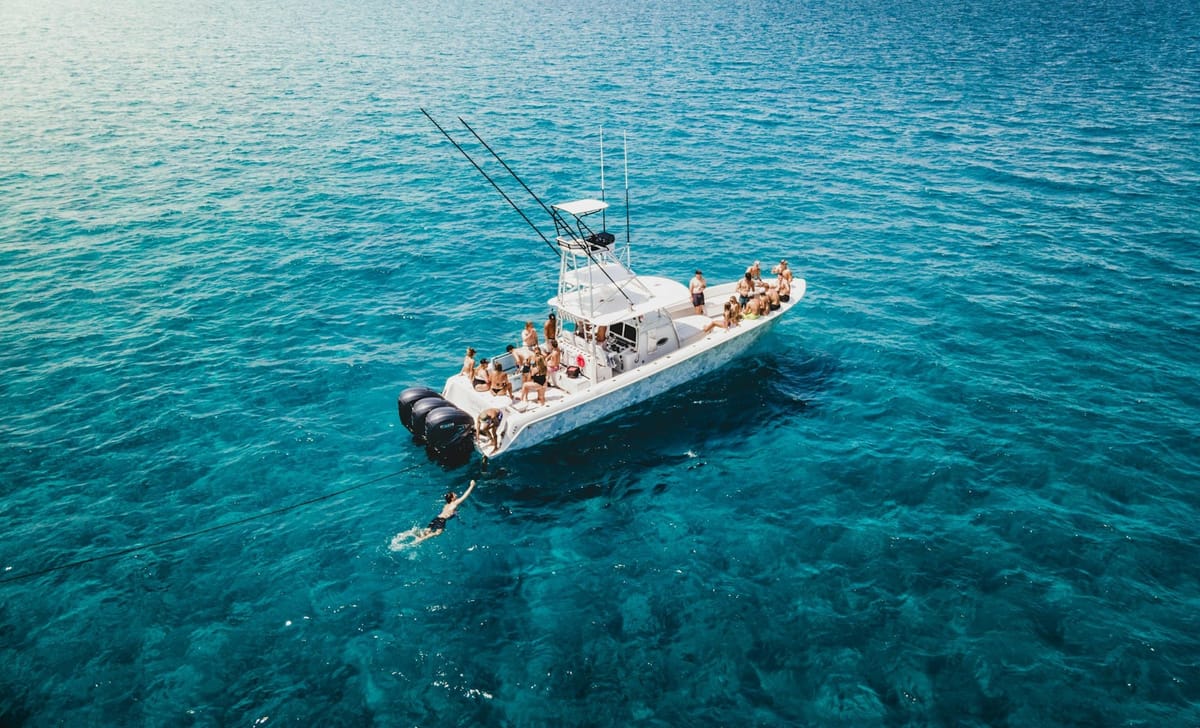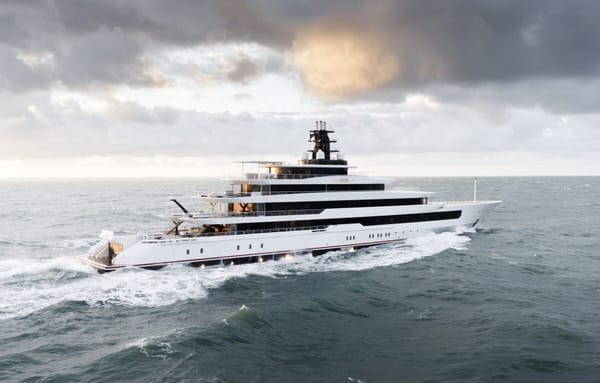Should You Rent a Yacht, or Buy One?
A comprehensive cost-benefit analysis.

Let's get this out of the way: if you're thinking of dropping $6,000 for a less-than-a-day rental of a decent yacht, you can afford to buy one. The real question is does it make sense for you personally — and the answer is less about finances and more about what you want to get from access to a yacht.
Lifestyle Considerations
There's one quick litmus test to determine that you probably should not buy any sort of boat: do you have zero access to large bodies of water at any time of year unless you're in a hotel? Definitely rent that yacht, then.
If you do live near a marina (even if only for part of the year), ask yourself what you like about the idea of a yacht: if you love deep-sea fishing, cruising from island to island, snorkeling, taking your friends or family out for fun, or just the adrenaline of hitting top speed over the waves (it's okay to admit it), then the central question is how happy those things make you — and how much happier you'd be to have the freedom to do them whenever you want.
Renting: Pros and Cons
Let's say you've been out on a yacht before, whether you rented it yourself or not, and you had a great time. Good! Now you'd like to spend more time on the water, but the cost of buying a yacht can be daunting. Well, you think, maybe I'll just rent one whenever I feel like it. Problem solved!
Let's dig into that, though. To keep the numbers sensible and even, I stuck to renting in one city (Miami, one of the top-ten U.S. yachting hubs).
I checked amenities, prices (including hidden fees, taxes, and gratuities), and policies from the ten largest companies I found, and attempted to reserve mid-size yachts of similar builds (mostly 50-60ft Azimut models advertised for up to 13 passengers, where I could find them); I also chose the longest single-day reservations available (mostly eight hours, though some were six). Prices varied from the well-documented luxury services with all the bells and whistles ($8,080) to the kinda-sketchy, not-much-information offerings with no extras and few, if any, pictures ($2,500) — but they averaged out to almost exactly $5,000.
(It's worth noting that my Google results also pulled up a few advisories on how to detect yacht charter scams before sending a wire transfer, as some charter companies only accept wires or cryptocurrency payments, so there's that.)
So let's say you want to go big (you do, trust me; I've read what you get when you don't), and you're ready to shell out about $7,000 on a chartered yacht for a day. What do you get? First of all, you probably won't get the entire boat: many charter companies don't make the cabins available, or not completely available, unless you're renting for multiple days (say, for a private trip to the Bahamas). This seems to be a common point of contention; most of the websites I looked at either didn't make that information obvious or didn't list it at all, and customers with large-ish groups left pretty pointed complaints. Another common complaint, particularly in the lower price ranges, was quite literally false advertising: customers would reserve a specific model, assume everything would go according to plan, and then, on the day of the rental, find themselves presented with a different yacht. In some cases, it was a more expensive yacht — the fine print made the customers responsible for the difference they didn't want. Another was boats that weren't entirely functional (!), or hadn't been cleaned; a number of customers across different companies complained that their chosen yachts were extremely late or had engine trouble, requiring a replacement — but not a refund.
All the companies I found provide 2-3 crew at minimum, including a captain, which is sensible: you don't need to buy insurance because you're not at the wheel, and the charter company a client yacht owner's investment by leaving it in skilled hands. Every company also provided pre-selected itineraries to choose from — and very few mentioned leaving Biscayne Bay (beyond that they're considered multi-day cruises, costing considerably more). Biscayne Bay is filled with things to see, but the vast majority of it, especially if you're anywhere near shallow water, traffic lanes, or bridges, is either no-wake/idle speed or minimal-wake/slow speed 1. Charter companies won't risk their businesses by tempting legal action — that means for most trips, you're not going for a joyride so much as a joy-float. Some charter companies allow customers to rent jet skis for an added fee (provided those customers have a boating license). One hopes they advise their customers that only certain itineraries really support it — renting a jet ski in a no-wake zone doesn't sound like a great time.
Aside from the crew, the itinerary, and (part of) the yacht, most companies didn't offer anything complimentary. I found one that stocked their yachts with snorkeling gear for free, but most either charged extra for any kind of water toys or didn't offer them at all. Additionally, some had what I felt were pretty draconian rules: no denim clothing, no red wine (what's the deposit for?), no balloons, no pets. One company put limits on how much alcohol guests can drink while aboard; another required life jackets for all kids 12 and under no matter the size of the yacht (this goes beyond Florida's laws — from the company's standpoint I think the added safety's reasonable, but I'd have been one sulky 12-year-old if I'd been forced to wear a life jacket for eight hours).

There's also the cancellation and/or refund issue: some companies offered no refunds at all; the pricier ones had better policies. Even so, most didn't offer free rescheduling for poor weather in the event of a relatively sudden change; most specified that only hurricanes or tropical storms would fit the bill. Imagine that you've spent $6,500 on a yacht for the day, you and your twelve friends don't have access to the cabins, and it starts to pour as you get out into the bay, but there's no actual hazard, so you're either staying out in it or eating that $6,500. Fun!
As in all things, if you're looking to rent or charter, follow the golden rule(s): read the terms and conditions before you sign or pay, and if it seems too good to be true, it probably is. The high-end superyacht charter world tends to offer more transparency and information — not to mention specific, non-interchangeable yachts — so if you really want that luxury cruise without the commitment of ownership, it may be worth your while to skip the small fries.
Mathing It Out
I broke out the calculator so you don't have to! Suppose you avoided negative experiences and decided to do this every single weekend of the year, each Saturday and Sunday. At an average of $5,000 — which, I'll mention again, isn't the full luxury experience — that'd run you a yearly bill of $520,000. The luxury experience: $840,320.
Nobody would do that, of course. Let's say you did it once a week: $260,000 average; $420,160 luxury. How about once a month? $60,000 average; $96,960 luxury.
In other words: eight hours of fun — maybe — with a lot of restrictions would cost you $5,000 a month for the average experience, or $8,080 for better guarantees. On top of that, no charter yacht company refreshes their fleet every year; it wouldn't make financial sense. That means you're likely renting a yacht that's 10-15 years old — maybe, for example, a 2011 55-foot Azimut.
Owning: Pros and Cons
Guess how much a well-maintained 2011 55-foot Azimut in Florida costs?
$599,000.
In the state of Florida, the maximum flat sales tax for a yacht is $18,000. Run that through a loan calculator: the first one I checked, with a 10% down-payment and a 20-year term, came up $4,219 a month. I knocked the initial payment down to $10,000 out of curiosity; the monthly payment only rose to $4,612. (Registration for a yacht of that size would max out at $202 depending on county; if you don't have a boating license, the most expensive class I found was $60.) You could always go the route of a boat loan... but interest rates are eye-watering and not showing any sign of shrinking.
Just to refresh, that means the monthly payment would be less than the sub-par once-monthly rental — and you'd be free to go wherever you want and do whatever you want, any day you want. (You don't need a crew on a smaller yacht, in case this is a question; charter companies provide them for liability reasons.) You can bring your dog! You can bring red wine (paper towels exist)! You can wear denim! You can access every single cabin! You can keep your own flamingo rafts and sea scooters! You can go do something else if it's raining without lighting thousands of dollars on fire! The world is your oyster.
That said, there are yearly costs, though the number's going to vary based on what you own and where you keep it. An oft-repeated rule of thumb is to budget 10% of the purchase price per year for upkeep: at the top end of all costs — that is, you're not handy with engines ($200-2,000), you're not cleaning your own hull (in Miami's warm waters, full service could run you $300 for a weekly wash, $300 for a monthly full clean, and around $2,000 for a fresh coat of anti-fouling paint), and you don't have your own dock — that wound up being a little low for a $600,000 50-foot motor yacht in Miami (notably, it's worth saying again, a very high-demand area for yacht services). The yearly cost of a slip at a marina can vary according to location (protected "hurricane holes" are prized in Florida), convenience, vessel size, and amenities; a high-end slip in Miami might cost $3,000 per month — but if you'd rather pocket some money in exchange for a little inconvenience, you can save thousands by looking up the coast. Insurance, too, depends on a number of factors; but in Miami's case, the likelihood of damaging storms and the year-round presence of saltwater vastly increases the cost of insuring any vessel — a test quote for our hypothetical 55-foot Azimut offered $20,000 per year. (In northern states, where winter haul-outs are the norm and some vessels are kept in fresh water, the base estimate was less than a third of that.) The cost of fuel is also a consideration: estimates are difficult to make because they vary by engine specs, efficiency, drag, fuel prices, and how hard you're planning you regularly push your engines; for something like a dual-engine mid-size Azimut, you might pay $15,000 annually. Newer innovations are helping larger yachts become more accessible, that said: many now come equipped with a joystick system that makes steering (and maneuvering a large yacht back into its slip) a breeze with no need for a captain. Hybrid-power yachts outfitted with solar panels are becoming more common, too, and if you're concerned about your carbon footprint, you can burn almost zero fuel with the original eco-friendly yacht.

But whether you're trying to go vertical at a million knots per hour or you just want a comfortable way to get to coral reefs and islands, it's the freedom to just go that makes owning a boat worth it. Even better, it's not just you who benefits: not much beats the feeling of offering to take your friends out on a yacht — no hired strangers complicating the good vibes, no arbitrary limitations; just an uncommon way to let your friends de-stress, and it's all yours.
The Short Version
Do you know nothing at all about yachts except that they exist for one-off parties? Are you pretty sure you get motion sickness? Are you heading to Florida from far, far away, just once, to see what it's like? Then yeah, rent that yacht in Miami. If you already know you like to be out on the water, you don't live too far from a marina, and it'd make you happy to be on a boat as often as you can, don't keep budgeting for rentals — rent twice, and you've already tossed a down-payment in the trash. Life's short: give yourself reasons to do things you like. ⛵︎
1 Florida Fish and Wildlife Conservation Commission.






